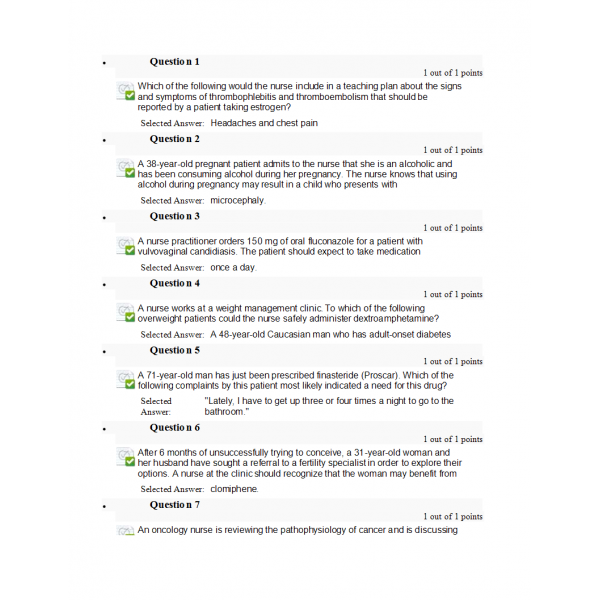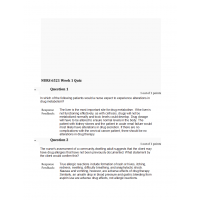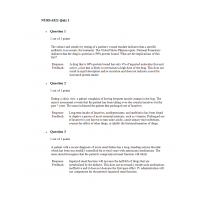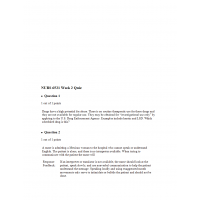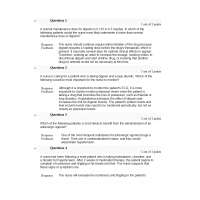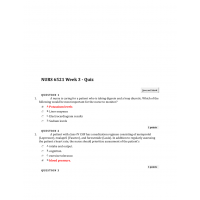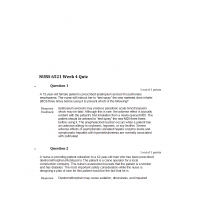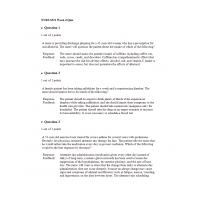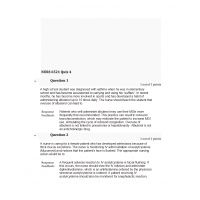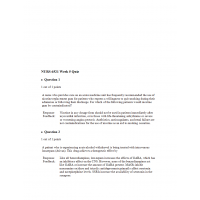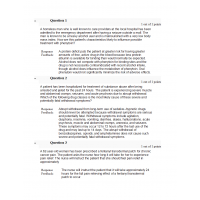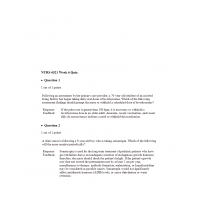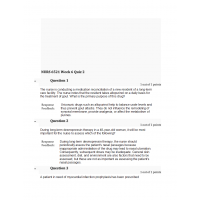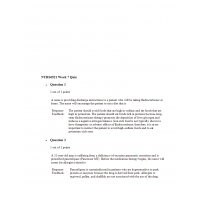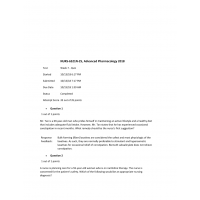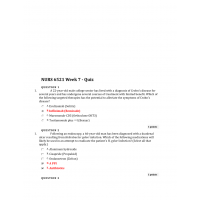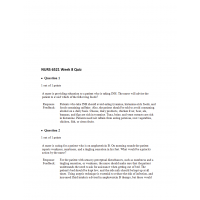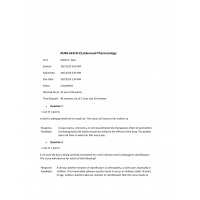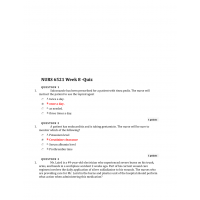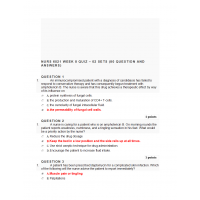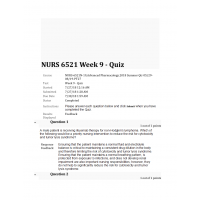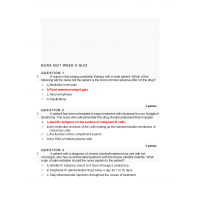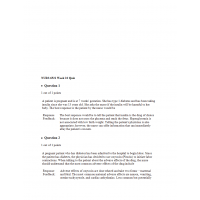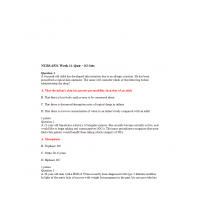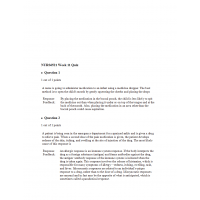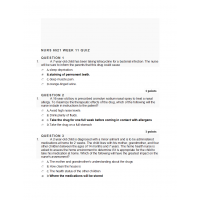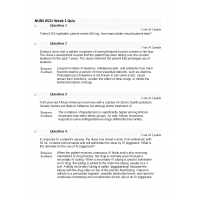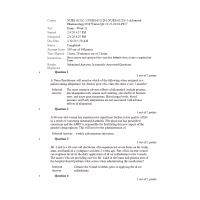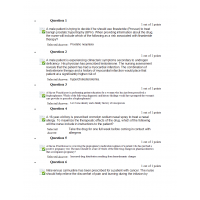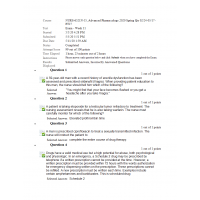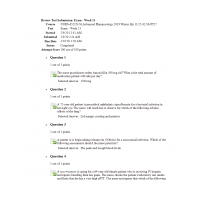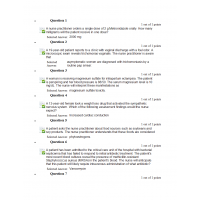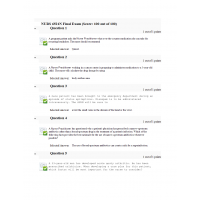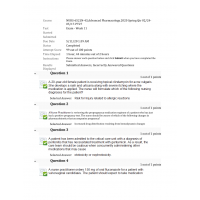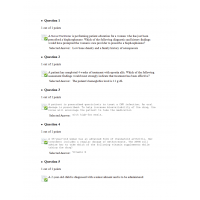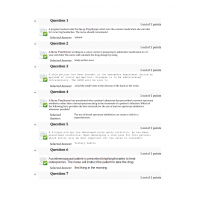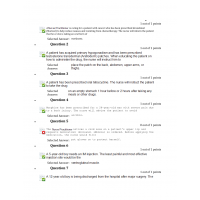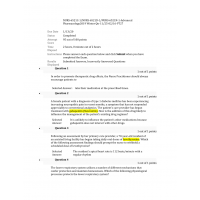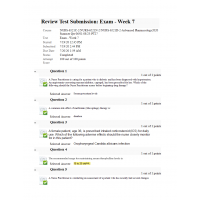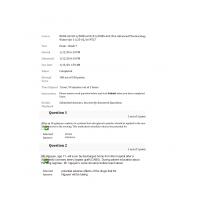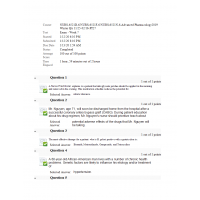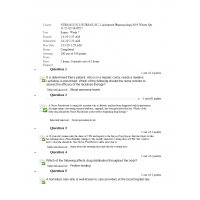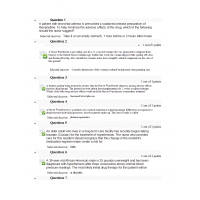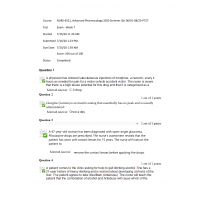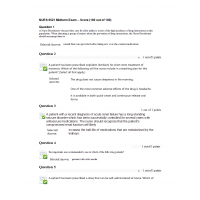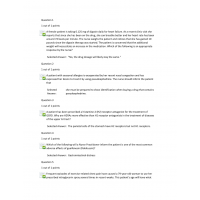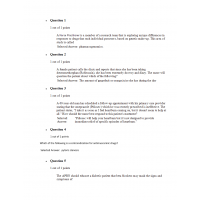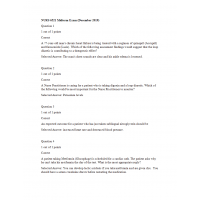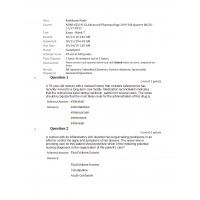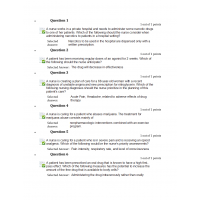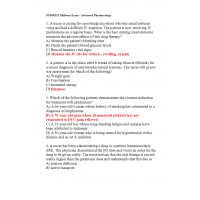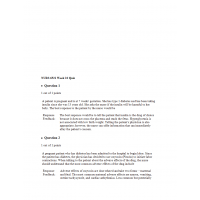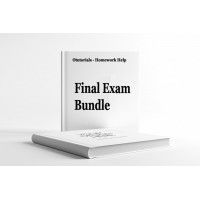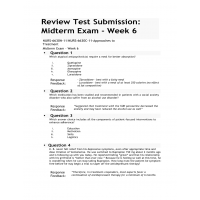NURS 6521N Final Exam 12 - Pharmocology (94/100 Points)
NURS 6521N Final Exam - Question and Answers
1. Which of the following would the nurse include in a teaching plan about the signs and symptoms of thrombophlebitis and thromboembolism that should be reported by a patient taking estrogen?
2. A 38-year-old pregnant patient admits to the nurse that she is an alcoholic and has been consuming alcohol during her pregnancy. The nurse knows that using alcohol during pregnancy may result in a child who presents with
3. A nurse practitioner orders 150 mg of oral fluconazole for a patient with vulvovaginal candidiasis. The patient should expect to take medication
4. A nurse works at a weight management clinic. To which of the following overweight patients could the nurse safely administer dextroamphetamine?
5. A 71-year-old man has just been prescribed finasteride (Proscar). Which of the following complaints by this patient most likely indicated a need for this drug?
6. After 6 months of unsuccessfully trying to conceive, a 31-year-old woman and her husband have sought a referral to a fertility specialist in order to explore their options. A nurse at the clinic should recognize that the woman may benefit from
7. An oncology nurse is reviewing the pathophysiology of cancer and is discussing with a colleague the factors that contribute to the success or failure of a patient's chemotherapy. Which of the following cancerous cells is most susceptible to the effects of chemotherapeutic drugs?
8. A middle-aged patient has received a diagnosis of GI stromal tumor following an extensive diagnostic workup. Imatinib has been recommended as a component of the patient's drug regimen. What patient education should the nurse provide to this patient?
9. A 12-year-old boy is being discharged from the hospital after major surgery. The boy will be taking two medications at home for an extended period. The nurse who is discharging the patient should provide medication teaching specifically to
10. A patient has been admitted to the critical care unit with a diagnosis of peritonitis that has necessitated treatment with gentamicin. As a result, the care team should be cautious when concurrently administering other medications that may cause
11. A 39-year-old woman is receiving doxorubicin for the treatment of cancer. After each treatment, the patient has acute nausea and vomiting accompanied by a slightly increased heart rate. The nurse will advise her to
12. A nurse is caring for a patient with cancer who has been prescribed dronabinol (Marinol) to help reduce nausea and vomiting from chemotherapy. The nurse will inform the patient that he or she is taking an oral form of
13. A 46-year-old man is receiving a quinupristin/dalfopristin IV infusion for a life-threatening infection. Which of the following would be most important for the nurse to monitor?
14. A woman is receiving prolonged drug therapy during her complicated pregnancy, and it may pose a risk to both the mother and the fetus. The primary care physician has made dosage adjustments to minimize adverse effects and prevent toxicity. The nurse should make sure
15. Alprostadil (Caverject), a drug used to treat erectile dysfunction, has been prescribed to a 42-year-old patient. When providing education to the patient and his wife, the nurse should inform the wife about which of the following adverse effects?
16. A 36-year-old patient comes to the clinic and tells the nurse that she suspects that she is pregnant. During the initial assessment, the nurse learns that the patient is currently taking medications for diabetes, hypertension, and a seizure disorder. The nurse would be most concerned about which of the following medications?
17. A male patient with a medical background tells the nurse that he is not satisfied with the oral synthetic testosterone that has been prescribed for him and he would like to try a natural form of oral testosterone. Which of the following would be an appropriate response by the nurse?
18. A male patient is trying to decide if he should use finasteride (Proscar) to treat benign prostatic hypertrophy (BPH). When providing information about the drug, the nurse will include which of the following as a risk associated with finasteride therapy?
19. A 2-year-old child is diagnosed with a minor ailment and is to be administered medications at home for 2 weeks. The child lives with his mother, grandmother, and four other children between the ages of 14 months and 7 years. The home health nurse is asked to assess the home environment to determine if it is appropriate for the child to take his medication at home. Which of the following will have the greatest impact on the nurse's assessment?
20. A 22-year-old woman has given birth to an infant who exhibits the signs and symptoms of maternal cocaine use during pregnancy. These signs and symptoms are a result of what pathophysiological effect of opioid use during pregnancy?
21. A 62-year-old patient taking tamoxifen exhibits increased bone and tumor pain along with a local disease flare. The nurse interprets this as an indication of which of the following?
22. A female patient is prescribed oprelvekin therapy to treat thrombocytopenia. Which of the following should the nurse continuously monitor to determine the efficacy and duration of the oprelvekin therapy?
23. The clinical nurse educator who oversees the emergency department in a children's hospital has launched an awareness program aimed at reducing drug errors. What measure addresses the most common cause of incorrect doses in the care of infants and children?
24. A patient has completed 4 weeks of treatment with epoetin alfa. Which of the following assessment findings would most strongly indicate that treatment has been effective?
25. A patient has been scheduled to begin treatment with rituximab for non-Hodgkin's lymphoma. The nurse who will administer this drug should understand that it targets
26. A 15-year-old boy has been diagnosed with bone cancer after several months of fatigue and pain. What question should the nurse include in an assessment when trying to minimize the potential for adverse drug reactions?
27. A 30-year-old man with a BMI of 59 has recently been diagnosed with type 2 diabetes mellitus. In light of the man's lack of success with weight loss programs in the past, his care provider has prescribed sibutramine (Meridia). What instructions should the nurse consequently provide to this patient?
28. A 49-year-old farmer who normally enjoys good health has become seriously ill in recent days and the results of an extensive diagnostic work up have resulted in a diagnosis of histoplasmosis. The patient has been admitted to the hospital and has begun treatment with amphotericin B. The nurse who is providing care for the patient should prioritize which of the following diagnostic results during his course of treatment?
29. A patient has just received her first dose of imatinib and the nurse on the oncology unit is amending the patient's care plan accordingly. What nursing diagnosis is most appropriate in light of this addition to the patient's drug regimen?
30. A 20-year-old female patient is receiving topical clindamycin for acne vulgaris. She develops a rash and urticaria along with severe itching where the medication is applied. The nurse will formulate which of the following nursing diagnoses for the patient?
31. Which of the following nursing actions is most important in achieving successful antimicrobial therapy with vancomycin?
32. A woman who is in the second trimester of her first pregnancy has been experiencing frequent headaches and has sought advice from her nurse practitioner about safe treatment options. What analgesic can the nurse most safely recommend?
33. A patient receiving high-dose cisplatin therapy exhibits symptoms of hypomagnesemia. Which of the following should the nurse suggest to help offset the magnesium losses from the cisplatin therapy?
34. A child is admitted to the burn unit with second and third degree burns on both arms and part of his or her face. When administering topical medications to the burned areas, the nurse should
35. An immunocompromised 7-year-old child was recently discharged home with a peripherally-inserted central line (PIC line) for home antibiotic therapy. He has now been brought to the emergency department by his mother and father with signs and symptoms of line sepsis. Upon questioning, the mother states that she has been removing the PIC dressing daily and washing the site with warm water and a cloth. What nursing diagnosis is most appropriate in this situation?
36. A 21-year-old female has a history of irregular menses. She recently became sexually active, and would like to begin taking oral contraceptives (OCs). The nurse practitioner recognizes that most likely this patient would benefit from taking which category of OCs.
37. A 3-year-old boy has developed otitis media and requires antibiotics. In order to increase the chance that the boy will take his prescribed medication, the nurse should
38. A nurse is providing patient education to a 13-year-old girl who was just diagnosed with type 1 diabetes mellitus. Which of the following statements by the patient will alert the nurse that special instructions regarding insulin are necessary?
39. A 28-year-old woman has completed rituximab therapy for an autoimmune disease. She tells the nurse that she and her husband would like to start a family. The nurse will advise her to
40. A 73-year-old woman has osteoporosis and is prescribed alendronate. She takes calcium and vitamin D supplements, drinks lots of water, and has just quit smoking. The nurse should advise the patient to also
41. A nurse is performing patient education for a woman who has just been prescribed a bisphosphonate. Which of the following diagnostic and history findings would have prompted the woman's care provider to prescribe a bisphosphonate?
42. A 20-year-old woman will soon begin taking oral contraceptives for the first time. What advice should the nurse provide to this patient?
43. A nurse is providing patient education to a 50-year-old woman who is taking methotrexate (MTX) for breast cancer. The nurse will instruct the patient to avoid which of the following drugs?
44. A nurse is instructing a 19-year-old female patient on the use of fluconazole for candida vaginitis. A teaching priority will be to
45. A nurse is assessing a patient who has chronic lymphoblastic myelogenous leukemia. The treatment plan includes hydroxyurea (Hydrea). The nurse will assess the patient for which of the following?
46. Mr. Singh is a 66-year-old man who is receiving chemotherapy for the treatment of lung cancer that has metastasized to his liver. In an effort to prevent infection, Mr. Singh has been prescribed filgrastim (Neupogen). Which of the nurse's following assessment questions most directly addresses a common adverse effect of filgrastim?
47. A preterm neonate received caffeine for the treatment of apnea. The nurse should monitor the neonate for which of the following?
48. A patient has been prescribed daptomycin for a complicated skin infection. Which of the following will the nurse advise the patient to report immediately?
49. A 7-year-old child has been taking tetracycline for a bacterial infection. The nurse will be sure to inform the parents that this drug could cause
50. Sulconazole has been prescribed for a patient with tinea pedis. The nurse will instruct the patient to use the topical agent
51. A nurse has questioned why a patient's physician has prescribed a narrow-spectrum antibiotic rather than a broad-spectrum drug in the treatment of a patient's infection. Which of the following facts provides the best rationale for the use of narrow-spectrum antibiotics whenever possible?
52. A female patient has been prescribed estrogen therapy. Which of the following will the nurse advise the patient is a common adverse effect of estrogen therapy?
53. A nurse is discussing oprelvekin therapy with a male patient. Which of the following will the nurse tell the patient is the most common adverse effect of the drug?
54. A man has a demonstrated history of androgen deficiency and the consequences of this health problem include an inability to maintain an erection. Which of the following medications would best address this patient's erectile dysfunction (ED)?
55. A female patient has follicular non-Hodgkin's lymphoma and is receiving thalidomide (Thalomid). It will be most important for the nurse to monitor this patient for which of the following?
56. A nurse has administered filgrastim to a diverse group of patients in recent months. Which of the following patients should the nurse observe for extremely elevated white blood cell counts following administration of the drug?
57. A nurse is aware that the concept of selective toxicity is foundational to antimicrobial therapy. Which of the following statements most accurately describes selective toxicity?
58. A 59-year-old man with a recent history of erectile dysfunction has been assessed and prescribed sildenafil (Viagra). When providing patient education to this man, the nurse should tell him which of the following?
59. A nurse has completed a medication reconciliation of a patient who has been admitted following a motor vehicle accident. Among the many drugs that the patient has received in the previous year is rituximab. The nurse would be justified in suspecting the patient may have received treatment for which of the following diseases?
60. A patient asks the nurse practitioner about food sources such as soybeans and soy products. The nurse practitioner understands that these foods are considered
61. A nurse is providing patient education to a 23-year-old woman who is starting the norelgestromin/ethinyl estradiol transdermal system (Ortho Evra). Because this is the patient's first time to use the birth control patch, the nurse will instruct her to apply the patch
62. A nurse is explaining the use of acyclovir therapy to a 72-year-old man. Nephrotoxicity is discussed as a major adverse effect in older patients. To minimize the risk of the patient developing this adverse effect, the nurse will advise him to
63. Which of the following patients will be at the greatest risk for anemia and would be the most likely candidate for epoetin alfa therapy?
64. A 35-year-old woman is on a weight-loss program and is to begin taking sibutramine (Meridia). After baseline physical data are obtained, the nurse will assess the patient's childbearing potential. The nurse will inform the patient that during sibutramine therapy she should
65. The nurse recognizes that the potential for teratogenic drug effects is not static throughout the prenatal and postnatal periods. The potential for teratogenic effects is highest during
66. On the advice of her sister, a 52-year-old woman has visited her nurse practitioner to discuss the potential benefits of hormone replacement therapy in controlling the symptoms of menopause. Which of the following responses by the nurse is most appropriate?
67. A 16-year-old boy is prescribed cromolyn sodium nasal spray to treat a nasal allergy. To maximize the therapeutic effects of the drug, which of the following will the nurse include in instructions to the patient?
68. A nurse who provides care on a pediatric unit of a hospital is aware that the potential for harm as a result of drug errors is higher among infants and children than adults. This fact is primarily due to
69. A nurse who provides care on a pediatric medicine unit has conducted a medication reconciliation of a recently-admitted patient. In light of the fact that the child takes methylphenidate (Ritalin), the nurse is justified in considering a history of what health problem?
70. A nurse is caring for a 64-year-old female patient who is receiving IV heparin and reports bleeding from her gums. The nurse checks the patient's laboratory test results and finds that she has a very high aPTT. The nurse anticipates that which of the following drugs may be ordered?
71. A 10-year-old boy is taking dextroamphetamine (Dexedrine) daily for ADHD. At each clinic visit, the nurse's priority assessment would be
72. A 9-year-old boy was bought to his primary care provider by his mother with signs and symptoms of hookworm infection and will be sent home with a prescription for mebendazole. When provided patient and family education, the nurse should teach the mother with which of the following measures to avoid reinfection following treatment?
73. A 43-year-old man has been diagnosed with active TB. He is prescribed a multiple drug therapy, including INH and rifampin. A priority assessment by the nurse will be to monitor which combination of laboratory test results?
74. During ongoing assessment of a patient receiving 5-FU therapy, the nurse finds the patient's platelet count to be 92,000 cells/mm3. The nurse should do which of the following?
75. A nurse is discussing with a 58-year-old male patient the causes of erectile dysfunction in men over 50 years of age. Which of the following will the nurse inform the patient is the primary physical cause of erectile dysfunction of men in this age group?
76. A patient has been admitted to the critical care unit of the hospital with bacterial septicemia that has failed to respond to initial antibiotic treatment. The patient's most recent blood cultures reveal the presence of methicillin-resistant Staphylococcus aureus (MRSA) in the patient's blood. The nurse will anticipate that this patient will likely require intravenous administration of what antibiotic?
77. A nurse is instructing a colleague on how an antimicrobial produces a therapeutic effect. Which of the following should be included in the nurse's teaching?
78. A 20-year-old woman has been prescribed estrogen. As with all women taking estrogen, the nurse will carefully monitor the patient for which of the following?
79. A nurse has been assigned to a 55-year-old woman who has a malignant brain tumor. The patient is receiving her first dose of carmustine. It will be critical for the nurse to observe for which of the following?
80. A man is prescribed ciprofloxacin to treat a sexually transmitted infection. The nurse will instruct the patient to
81. A 66-year-old man has made an appointment with his primary care provider to discuss his recent erectile dysfunction (ED) and has requested a prescription for tadalafil (Cialis) based on television commercials he has seen. What characteristic of this patient would most likely contraindicate the use of tadalafil for his ED?
82. A nurse is caring for a patient who is at 28 weeks' gestation and is receiving terbutaline (Brethine) to control preterm labor. Which of the following assessment parameters should the nurse prioritize?
83. A patient with non-Hodgkin's lymphoma (NHL) will be starting a course of doxorubicin shortly. When planning this patient's care, what nursing diagnosis should the nurse prioritize?
84. A patient is taking rifampin (Rifadin) for active TB. When discussing this drug with the patient, the nurse should stress that
85. A nurse is administering rituximab to a patient via the IV route. The nurse will set the IV pump at 50 mg/hour for the first half hour of the initial infusion. If there are not apparent reactions after 30 minutes of the infusion, the nurse will increase the dosage every 30 minutes by 50 mg/hour until the maximum infusion rate reaches which of the following?
86. A 60-year-old patient experienced a sudden onset of chest pain and shortness of breath and was subsequently diagnosed with a pulmonary embolism in the emergency department. The patient has been started on an intravenous heparin infusion. How does this drug achieve therapeutic effect?
87. A patient will soon begin targeted therapy as a component of her treatment plan for chronic leukemia. The nurse is conducting health education about this new aspect of the patient's drug regimen and the patient has asked about the potential side effects of treatment. How should the nurse best respond?
88. A patient is taking etoposide for a testicular tumor refractory to treatment. The nursing assessment reveals that he is also taking warfarin. The nurse must carefully monitor for which of the following?
89. A patient is receiving long-term clindamycin therapy for a life-threatening infection. The nurse will begin by monitoring this drug therapy by obtaining
90. A patient is prescribed ganciclovir to treat a CMV infection. An oral dosage is prescribed. To help increase bioavailability of the drug, the nurse will encourage the patient to take the medication
91. A 29-year-old woman who is morbidly obese has recently begun a comprehensive, medically-supervised program of weight reduction. Prior to adding dextroamphetamine (Dexedrine) to her regimen, the patient should be questioned about her intake of
92. A patient is pregnant and is at 7 weeks' gestation. She has type 1 diabetes and has been taking insulin since she was 13 years old. She asks the nurse if the insulin will be harmful to her baby. The best response to the patient by the nurse would be
93. A nurse is explaining to the parents of a 6-year-old child suffering from angina why nitroglycerin patches for chest pain would not be appropriate. Which of the following will the nurse include in an explanation?
94. Mr. Lepp is a 63-year-old man who was diagnosed with colon cancer several weeks ago and who is scheduled to begin chemotherapy. He reports to the nurse that he read about the need for erythropoietin in an online forum for cancer patients and wants to explore the use of epoetin alfa with his oncologist. Which of the following facts should underlie the nurse's response to Mr. Lepp?
95. A patient with a diagnosis of chronic myeloid leukemia has met with her oncologist, who has recommended treatment with the kinase inhibitor imatinib. What route of administration should the nurse explain to the patient?
96. A nurse is going to administer medication to an infant using a medicine dropper. The best method is to open the child's mouth by gently squeezing the cheeks and placing the drops
97. A nurse practitioner orders a single dose of 2 g Metronidazole orally. How many milligrams will the patient receive in one dose?
98. A patient is being treated for Mycoplasma pneumoniae pneumonia. She is allergic to penicillin and is being given azithromycin (Zithromax) in capsule form. The nurse will inform the patient that she will need to take the capsule
99. A nurse is explaining to a pregnant 21-year-old college student why she cannot continue to take ibuprofen (Advil) for her headaches. The nurse draws a picture depicting drug molecules crossing the placental membrane and entering into the fetal circulation. The nurse tells the patient that the main reason this happens is because
100. A patient has been prescribed oral tetracycline. The nurse will instruct the patient to take the drug
| Institution & Term/Date | |
| Term/Date | Walden University |
-
$40.00
Related Products
Tags: NURS 6521N

